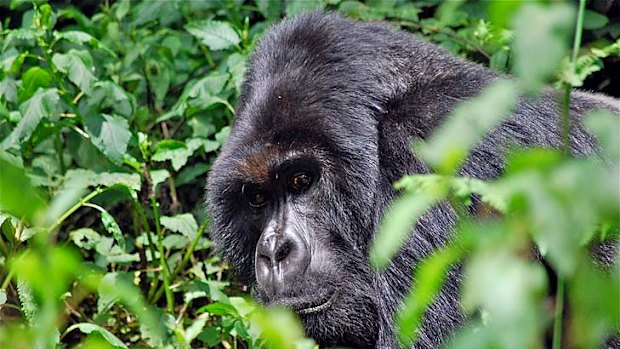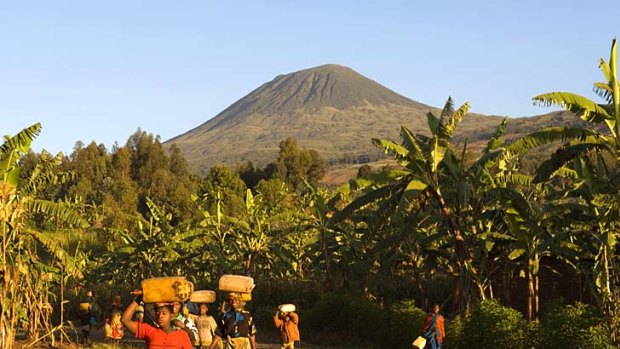
A silverback gorilla in Rwanda.Credit: Robert Upe
Robert Upe stares, spellbound, into the eyes of endangered mountain gorillas - until one doubles back.
Border crossings in Africa can be long-winded. Lines of trucks packed with fruit, vegetables and other cargo stretch for kilometres, sometimes waiting in queues for 24 hours. Fortunately, overland tourists usually pass through the chaos within an hour or two.
The customs office at the Uganda-Rwanda border, where I'm crossing, is a single-room stone house with an old desk and a chair in the far-right corner. People crowd around to collect their stamped passports from the harassed official.

The approach to Rwanda's Volcanoes National Park.Credit: Alamy
Nearby, hawkers under tatty beach umbrellas and canvas awnings on the street try to sell travellers useless items such as soccer boots. But there are also suitcases for sale on their benches, and pineapples, freshly sliced watermelon, bananas and Coca-Cola.
Beggars approach with hands out and men who you feel should have glinting gold teeth look for quick deals to exchange Ugandan shillings for Rwandan francs "at the best rates".
On the edges, suspicious "businessmen" in tired grey suit jackets offer new arrivals all sorts of services: hotel bookings, a ride on bicycles or motorbikes, guiding to anywhere (including the neighbouring no-go zone of the Democratic Republic of Congo).
In the middle of this mayhem, serious-looking but uninterested border guards stand around with Kalashnikovs slung over their shoulders.
It's a circus, and border protection appears to take second place to enterprise. So it's a surprise that on the night of August 8 last year, Rwandan guards at a nearby crossing found a baby mountain gorilla drugged and hidden in a vegetable crate and arrested three smugglers who said they had paid $US15,000 for the traumatised infant.
The poaching of gorillas for private collections or for bush meat (still fancied in some parts of central Africa, though not Rwanda, where it is taboo) continues to pose a threat to the population of endangered mountain gorillas.
According to the most recent reports, the population is rising slowly but there are only about 790 in the world, all in the Virunga Volcano region of Rwanda, the Democratic Republic of Congo and Uganda.
In this kidnapping case, the unconfirmed but widely circulated rumour was that a private collector in the Middle East had ordered the baby gorilla for $US100,000.
Gorillas require care from their mothers for the first three years of life and rarely survive captivity in amateur private collections. If the alert guards hadn't rescued it, this baby, named Ihirwe ("Lucky" in Rwanda's native language, Kinyarwanda) would probably be dead now.
When baby gorillas are stolen, the family members are usually killed because the adult gorillas will not give up their young. It doesn't take much to turn the stomach if you start imagining the panic of the gorillas as they are slaughtered and a baby desperately clutching a dead mother. A few years ago, the smugglers caught at the border would have faced execution, but a change in the law now means life in prison, a local tells me.
The jungle on the volcanic slopes where the gorillas live in Rwanda's Volcanoes National Park is riddled with stinging nettle, vines, bamboo thickets, steep areas and mud that sucks the shoes off you. The only way forward is via machete. If you don't watch your step, you can slip into an abyss camouflaged by jungle foliage and take a painful and muddy slide to the bottom of a hill, probably landing bum up in a shallow rocky river.
Despite the difficult terrain, gorilla tourism is booming. Rwandan authorities claim dubious visitor figures of about 800,000 a year, but tourism sources in the country estimate about 29,000 tourists arrive each year just to see the gorillas. Each tourist pays the daily gorilla permit fee of $US500 ($484); this rises to $US750 on June 1.
Our group, with adventure tour company Peregrine, rises at dawn to get to the mountains, with permits and gardening gloves in hand for a close encounter with the apes.
We've stayed overnight at the Mountain Gorilla View Lodge at the gorilla gateway town of Musanze (until recently named Ruhengeri). The lodge is a peculiar place to stay - its stone cottages are so cavernous you can almost create an echo within the walls and slate floor. In the main room of my very private cottage surrounded by jungle garden is a small sofa and table, a double bed and a fireplace. There is so much space in between the furniture you could play soccer. The boots for sale at the border might have been handy after all.
Mist-covered volcanoes surround the lodge and once the sun dips behind the mountains it gets chilly. Late in the day, staff arrive to light the rooms' fires but frustratingly - until I start tipping them $US1 a visit - they never leave enough wood to provide a warming blaze. Hot-water bottles arrive at bedtime.
It's not far from the lodge to the headquarters of the Volcanoes National Park, from where gorilla treks depart daily. Three more gorilla families have been habituated recently, so there are now 10 families to visit and a maximum of 80 permits issued a day.
Sometimes it can be a short and easy walk to find the gorillas; at other times it can take many hours in tough conditions.
Once contact with the animals is made, each group's presence is limited to one hour so the gorillas are not stressed. Anyone who declares he or she is feeling ill or looks unwell is not allowed into the park, because human diseases can devastate the fragile gorilla population. Our guide, Francis Ndagijimana, eyes us carefully and tells us we will be on the trail of the Bwenge (Wisdom) group this morning. An advance party of trackers has already radioed news that they have found the family of nine near the edge of the jungle.
"If you fall or get stung [by stinging nettle], suffer in silence," Ndagijimana says. "If you make a loud noise the gorillas may think you are making a threatening sound."
The group sets off quietly on terraced fields where farmers grow potatoes, keep goats and live in simple bamboo-framed mud huts. Ten per cent of the money from our permit fees goes to this community and is used to provide services such as clean water and job-creation schemes including bee-keeping.
About 400 guides and trackers are employed here for the gorillas and it is estimated their salaries support 4000 people in the area. One of the guides, Francois Bigirimana, worked in these mountains in the 1960s and '70s with zoologist Dian Fossey, immortalised in Gorillas in the Mist, starring Sigourney Weaver. Fossey lived among the gorillas and, as well as carrying out scientific work, campaigned against poaching.
As we climb the terraces, Ndagijimana points into the distance towards the saddle of two volcanoes named Karisimbi and Visoke. This is where Fossey established her research station, Karisoke (a combination of the two volcano names), and where she was buried after being murdered in 1985 with a machete blow to the head. Poachers are often blamed for the unsolved murder, but there are other theories. One suggests she was killed by people with financial interests in developing gorilla tourism, which Fossey opposed because of the health risks to the apes.
After an hour of climbing, we're at the top of the terraces and catching our breath on the jungle's edge. We need to leave our day packs, water bottles and bamboo walking sticks behind. Some in the group have hired porters for a few dollars to help them over uneven ground, but they, too, have to remain here. The only thing we can take into the jungle is a camera.
As soon as we move into the thick vegetation we're in a maze of bamboo, ankle-deep in mud and wrapped in vines that trip and choke us. The stinging nettles bite through our long trousers, but at least gardening gloves protect our hands. Mercifully, within 15 minutes we're with the gorillas.
Ndagijimana makes well-practised grunting noises to assure them we are no threat. We're within metres of the group, who are seated, grazing on foliage. Their red eyes stare into ours.
The babies are balls of black fur. They stay close to their mothers but take the occasional playful tumble and roll. If the babies touch us, we're told not to touch them back.
The big silverback who commands the troop weighs more than 200 kilograms. He evaluates us and moves on. Everyone follows him, including the humans.
The terrain makes it difficult to keep up and we only catch the troop again when it stops to graze. Luckily this is often; gorillas spend 30 per cent of their time eating.
As they continue to move effortlessly through the foliage, we continue stumbling and falling behind our machete-wielding guide. Photography is difficult because lenses steam up in the jungle heat.
At one point we're a little too close for comfort when the gorillas double back to where we stand. This is when a female gorilla charges at Ndagijimana, who scoots forward and arches his back to avoid being bitten.
"She wanted to bite me because we were in the way," he says later. "That was OK. The problem is that when she makes an agitated noise, the silverback may come over and intervene. Then there will be real problems."
During our designated hour we continue to trail the gorillas, stopping and starting as they eat and run. Despite the "incident", they appear calm and loving, the females constantly cuddling the young.
They don't seem to have a care in the world - until the poachers arrive.
Robert Upe travelled courtesy of Peregrine Adventures.
FAST FACTS
Getting there
Etihad began flights to Nairobi, Kenya, last month; it has a fare from Sydney and Melbourne for about $1840 low-season return, including tax. Fly to Abu Dhabi (about 14hr), then Nairobi (4hr 50min); see etihad.com. Emirates has a fare to Nairobi from Sydney and Melbourne via Dubai for about $2665 low-season return, including tax; see emirates.com. Kenya Airways has a fare from Nairobi to Kigali, Rwanda (90min), for about $330 return, including tax; see kenya-airways.com. Australians require a visa for a stay of up to 15 days. This is issued on arrival for $US60 ($57) and requires an entry facility letter; see migration.gov.rw.
Touring there
Peregrine has five tours to Rwanda that visit the gorillas. Among them is the four-day Mountain Gorillas of Rwanda trip that departs daily from Kigali and includes accommodation at Mountain Gorilla View Lodge, from $2770 a person, twin share. The 15-day Best of East Africa trip includes a gorilla visit during an overland journey through Kenya, Uganda and Rwanda, from $6815 a person, twin share. Phone 1300 854 500, see peregrineadventures.com.
Seeing the gorillas
Rwanda's Volcanoes National Park is the easiest place to see mountain gorillas. Uganda's Bwindi Impenetrable National Park also has mountain gorillas but it lives up to its name. There are mountain gorillas in the Democratic Republic of Congo, but the Australian Department of Foreign Affairs and Trade warns that travellers should not venture there. A population of lowland gorillas is scattered across west Africa.
The global population of 790 mountain gorillas is threatened by poaching for private collections and the meat trade, deaths in snare traps set for other animals and transmission of human disease.
Sign up for the Traveller Deals newsletter
Get exclusive travel deals delivered straight to your inbox. Sign up now.